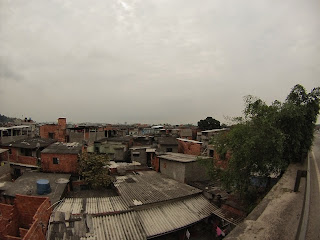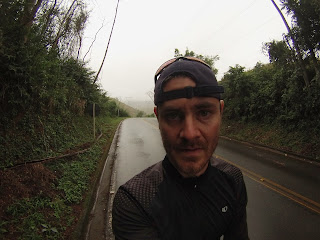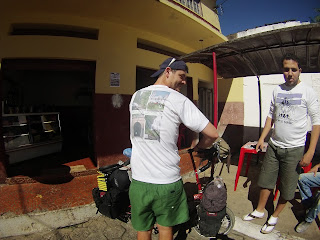The padre was out. A woman was breastfeeding at the steps of the church. I asked her to watch my bike while I went out for groceries. When I returned, one of the family members had left a misto quente—a ham and cheese sandwich-- on my handlebar bag wrapped in a paper towel. I ate it quickly and brought my gear and bike to an empty second story balcony in the church. I slept for a while and waited for the padre to return. The padre arrived and told me it was OK to camp for the night, but asked me a few questions: -what the hell was I doing on my bike? –did I have others with me? –did I plan on using drugs? I put the father at ease and set up camp. Soon the church bells rang and the church was packed. Brasil beat Spain that night 3-0 and fireworks went off throughout the city.
It was a tough climb to Mendes but I made it by mid-day. A gal on a bike noticed I looked lost, and helped me find Alex’s home. I had met Alex in Rio at the guest house and he had invited me to stay at his family’s house. When we eventually found Alex’s house, the two recognize each other—they had gone to high school together and hadn’t seen each other in ages. The three of us hung out a bit and we planned my route up to Minas Gerais.
Alex’s parents were very generous hosts and his mother cooks very well. Later that night Alex and I met up with one of his good friends and we discussed Brazilian economics, among other topics, over beers.
In the morning Alex and his parents were off to work at the family business. I packed a ham and cheese sandwich in my bag, gathered my gear, and headed off to the town center where Alex’s father ran a busy hardware store.
Alex’s father recommended I head in the direction of Conservatória. I headed out of town, then 10km of a rough dirt road, then climbed in the rain to the town center of Conservatória. I stopped for a beer at a small store and ran into Ivan, who offered to let me sleep at his fazenda. I insisted on camping, but he generously offered me a bed in his pousada.
I followed Ivan’s car to his fazenda and Pousada. The land had been in his family for 4 generations (originally from England, and he had a coat of arms describing his family’ history in England, which dated back to 1279. I met Ivan’s wife, Kristiana, and his cousin, Gustavo. Gustavo’s family had land slightly east of Ivan’s fazenda. This land, too, had been in Gustavo’s family for 4 generations. I spent 3 hours speaking with Gustavo, Ivan, and Ivan’s wife. Gustavo drew a map for me for my riding tommorrow and his drawing revealed fazendas, waterfalls, and villages my map did not have.
That night Gustavo, Ivan’s cousin, Christiana, Ivan’s wife, and I ate ate a soup of manjioca, potatoes, leeks, spaghetti, carrots, and onions with bread. I then spent another 2 hours speaking with Gustavo about other parts of Brazil worth exploring and a waterfall nearby. I spoke with Gustavo until 10 about the natives of Brasil before the time of the Europeans. He spoke about his passion of watching the stars and we both agreed it was a lost art to gaze at the stars and that most people forgot the stars existed in the skies. Gustavo was a man of courage and intelligence. He was also working on a house near Ivan’s land were he would settle and live. Eventualy we said goodnight, as I was cold and tired.
Ivan offered for me to stay as long as I liked. I tried to wash some dishes to somehow contribute but Kristiana thought this was silly and washed the rest of the dishes.
The next morning after breakfast I headed out with Gustavo to take a look at the construction of his home.
Gustavo departed on his 4x4 and I followed him down a muddy dirt road. We stopped by the small waterfall and it was pretty. We rode on to the construction site of his home. There were small hills to the south, large bamboo trees to the north, a river and jungle vegetation to the east.
There were 6 men working on the home, one local expert operating a Case earth moving machine, the ohers pounding away on the second story foundation with manual earth flattening tools. I spoke with two of the main workers, both from Conservatória. Conservatória, as an aside, was once an Indian reserve, hence its name. It is now famous for its sad love music, serenata.
I watched the man with the machine lift trees while two other men helped. I then watched the same man lift huge stones and move them to better protect a bridge in a river. The man had a thermos of coffee and gave me some hot sweet coffee. We were there until 1 in the afternoon. We rode back to Ivan’s house and I ate a lunch of pork, rice and beans (feijão com arroz), and salad. Again, Kristiana's food was among the best I have eaten in Brasil.
I went with Gustavo to see a nearby Fazenda, and I met Anderson and his 6 year old son, who led me to the inside of a large building that had on old coffee processing machine used by the slaves and a large, old asphalt field used by the slaves to dry the coffee. There was a sauna, a large main home for the rich family from Rio that would visit. A home for Anderson and his family. 56 acres.
I rode back with Gustavo. Later that night, Ivan’s friend, Pito, arrived and we drank coffee and Gustavo and Pito talked business. Pito worked in heavy metal making machinery but was helping Gustavo with an electric hookup from the city. I went with Pito to drink beer at the place I first met Ivan. We drank a few bottles of beer and spoke of the tranquil life, as Pito had lived in Rio for 2 years and could see the contrast. We agreed Brasil had a bright future.
We drove through the city and through an old tunnel, the crying tunnel, built by the slaves, and I saw the old stone roads and old buildings of Conservatoria. We returned and drank bottles of beer with Ivan and Gustavo and Kristiana until midnight.
The next day I set off on a 30 mile off-road trail to fazenda Santa Clara, a fazenda with 365 windows, many of them painted on the walls of the edifice.The ride took me 4 hours and some sections were very rough, some sections very muddy, but all of it was very beautiful. Santa Clara was recently purchased by an American and wasn’t open for tours, but a worker showed me around and I saw the slave quarters and coffee processing equipment.
I rode another 23 km on a smooth dirt road over rolling hills to Santa Rita de Jacutinga. A certain Gigi stopped me on his motorcycle and insisted that he could find me a cheap room for the night. I followed Gigi to a clothing store, where a woman directed me slightly outside the town center. Waiting for me when I arrived was Eduardo, a young man native to Santa Rita whose family owned the pension. I spend the next afternoon sharing stories of adventures with Eduardo. He had explored some of the tallest mountains of Brasil and showed me many photos of his journeys. He also had a music reproduction business, a tourist business, was a computer expert, and ran the pension. As I was departing, Eduardo gave me a t-shirt he had just produced—photos of the two famous waterfalls, the cathedral, and the stone tunnel. It was a particularly good gift as I did not have a synthetic short sleeved t-shirt for colder rain.
I left mid-day for Bom Jardim de Minas, 30km of climbing, 5 km of descending through a lush, green mountain with several waterfalls.
Bom Jardim was very peaceful and I found a very cheap and simple room run by an old couple. I sat with the old woman for an hour and she gave me advice on where to go next—but in many cases it involved my zigzagging back and forth across Minas Gerais. She grew coffee in her garden in back and had six plants. It was a lot of work for a cup of coffee and her son did most of the work.
I tried the mineiro version of the chicken salgado with ham and it was the richest I had eaten in Brasil. I tried the Pão de queijo mineiro and it was much larger than the Paulista or Carioca version and the cheese was more evenly distributed in the center.
That night a huge old, truck pulled up at the pension with two old truck drivers. One man approached me: “Tenho que dormir,” I have to sleep, he said. While he went inside to get a room, I approached the driver’s window. Silvio had 9 women, not quite wives, but nine women. With them he had 27 children, and 14 grandchildren. I was slightly perplexed at the number of grandchildren in proportion to the children, as Silvio looked about 70. He had some rough words about the husbands and boyfriends of some of his daughters—many of the men were vagabonds, some were in and out of prison. Some of them had drug issues. I told Silvio not to worry. He was a hard worker and set a good example for his children. They would all eventually follow his lead, I assured him. In any case, he didn’t know the names of any of his grandchildren, he knew the names of the children he had himself named (4 of them), but knew the name of each of his women. He recited each of them to me, and when he would reach to the back of his mind to remember a name of one of his women, a smile would appear, and her name would come from his lips.
-----------------------------------------
My last night at the guest house in Rio. A group of Brazilian musicians played Irish music.
Leaving Rio
Just outside of Rio, the scenery began to change.
The misto quente left for me
Spot the tent
Sunday mass
Overlooking Japeri
The hardware store of Alex's family
Not happy with cold rain and climbing
Myself and Ivan
Kristiana, myself, Ivan
The next 4 photos are at the construction site of Gustavo's home
The next 9 photos are of the fazenda in Conservatoria
This is 200 year old coffee processing machinery, once operated by slaves. The machinery lies idle now.
Gustavo and Anderson's son. Anderson and his family manage the land for another family, but pretty much have the 56 acre place to themselves.
The crying tunnel of Conservatoria. Built by slaves.
I was not enthusiastic about this stretch of road. Mud is very bad for a bike, and I didn't know when it would end. Fortunately, just 1k of mud.
The next 6 photos are of fazenda Santa Clara
My new shirt given to me by Eduardo (to the right)
Brasil has many waterfalls. If you sit under a waterfall, it refreshes the spirit and removes negative energy.






































































